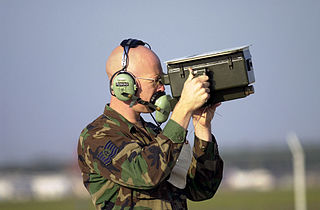Related Research Articles

The NATO Integrated Air Defense System is a command and control network combining radars and other facilities spread throughout the NATO alliance's air defence forces. It formed in the mid-1950s and became operational in 1962 as NADGE. It has been constantly upgraded since its formation, notably with the integration of Airborne Early Warning aircraft in the 1970s. The United Kingdom maintained its own network, but was fully integrated with the network since the introduction of the Linesman/Mediator network in the 1970s. Similarly, the German network maintained an independent nature through GEADGE.

The Joint Tactical Information Distribution System (JTIDS) is an L band Distributed Time Division Multiple Access (DTDMA) network radio system used by the United States Department of Defense and their allies to support data communications needs, principally in the air and missile defense community. It produces a spread spectrum signal using Frequency-shift keying (FSK) and Phase-shift keying (PSK) to spread the radiated power over a wider spectrum (range of frequencies) than normal radio transmissions. This reduces susceptibility to noise, jamming, and interception. In JTIDS Time Division Multiple Access (TDMA) (similar to cell phone technology), each time interval (e.g., 1 second) is divided into time slots (e.g. 128 per second). Together, all 1536 time slots in a 12-second interval are called a "frame". Each time slot is "bursted" (transmitted) at several different carrier frequencies sequentially. Within each slot, the phase angle of the transmission burst is varied to provide PSK. Each type of data to be transmitted is assigned a slot or block of slots (channel) to manage information exchanges among user participation groups. In traditional TDMA, the slot frequencies remain fixed from second to second (frame to frame). In JTIDS TDMA, the slot frequencies and/or slot assignments for each channel do not remain fixed from frame to frame but are varied in a pseudo-random manner. The slot assignments, frequencies, and information are all encrypted to provide computer-to-computer connectivity in support of every type of military platform to include Air Force fighters and Navy submarines.
In NATO, a standardization agreement defines processes, procedures, terms, and conditions for common military or technical procedures or equipment between the member countries of the alliance. Each NATO state ratifies a STANAG and implements it within its own military. The purpose is to provide common operational and administrative procedures and logistics, so one member nation's military may use the stores and support of another member's military. STANAGs also form the basis for technical interoperability between a wide variety of communication and information systems (CIS) essential for NATO and Allied operations. The Allied Data Publication 34 (ADatP-34) NATO Interoperability Standards and Profiles which is covered by STANAG 5524, maintains a catalogue of relevant information and communication technology standards.

Identification, friend or foe (IFF) is a combat identification system designed for command and control. It uses a transponder that listens for an interrogation signal and then sends a response that identifies the broadcaster. IFF systems usually use radar frequencies, but other electromagnetic frequencies, radio or infrared, may be used. It enables military and civilian air traffic control interrogation systems to identify aircraft, vehicles or forces as friendly, as opposed to neutral or hostile, and to determine their bearing and range from the interrogator. IFF is used by both military and civilian aircraft. IFF was first developed during World War II, with the arrival of radar, and several friendly fire incidents.
NATO Joint Military Symbology is the NATO standard for military map symbols. Originally published in 1986 as Allied Procedural Publication 6 (APP-6), NATO Military Symbols for Land Based Systems, the standard has evolved over the years and is currently in its fifth version (APP-6D). The symbols are designed to enhance NATO's joint interoperability by providing a standard set of common symbols. APP-6 constituted a single system of joint military symbology for land, air, space and sea-based formations and units, which can be displayed for either automated map display systems or for manual map marking. It covers all of the joint services and can be used by them.
Link 16 is a military tactical data link network used by NATO members and other nations, as allowed by the MIDS International Program Office (IPO). Its specification is part of the family of Tactical Data Links.
TADIL-J refers to the system of standardized J-series messages which are known by NATO as Link 16. These are defined by U.S. military standard (MIL-STD) 6016. It is used by the U.S. Navy, U.S. Army, U.S. Marine Corps, U.S. Air Force, U.S. Coast Guard, the NSA, several NATO countries, and Japan as part of the Multi-Tactical Data Link Network, a Tactical Data Link.
TADIL-A/Link 11 is a secure half-duplex tactical data link used by NATO to exchange digital data. It was originally developed by a joint committee including members from the Royal Canadian Navy, US Navy and Royal Navy to pass accurate targeting information between ships. The final standard was signed in Ottawa in November 1957, where the British proposed the name "TIDE" for "Tactical International Data Exchange". It was later made part of the NATO STANAG standardization process.

The Integrated Truss Structure (ITS) of the International Space Station (ISS) consists of a linear arranged sequence of connected trusses on which various unpressurized components are mounted such as logistics carriers, radiators, solar arrays, and other equipment. It supplies the ISS with a bus architecture. It is approximately 110 meters long and is made from aluminium and stainless steel.
The Joint Range Extension Applications Protocol (JREAP) enables tactical data messages to be transmitted over long-distance networks, e.g. satellite links, thereby extending the range of Tactical Data Links (TDLs).

A tactical data link (TDL) uses a data link standard in order to provide communication via radio waves or cable used by NATO nations. All military C3 systems use standardized TDL to transmit, relay and receive tactical data.

The DRDO Airborne Early Warning and Control System (AEW&CS) is a project of India's Defence Research and Development Organisation to develop an airborne early warning and control system for the Indian Air Force. It is also referred to as NETRA Airborne Early Warning and Control System (AEW&CS).

Multifunctional Information Distribution System (MIDS) is the NATO name for the communication component of Link-16.

ARKONA (ACCS) (German: ARKONA (FüWES)) is an Air Command and Control System of the German Air Force.

ADMAR, an initialism for the German title Abgesetzte Darstellung von MADAP Radar data, was the predecessor product of CIMACT.
GIADS - German Improved Air Defence System - is the standard Air Command and Control System of the German Air Force Tactical Command and Control Service.

The British Aerospace Nimrod AEW3 was a proposed airborne early warning (AEW) aircraft which was to provide airborne radar cover for the air defence of the United Kingdom by the Royal Air Force (RAF). The project was designed to use the existing Nimrod airframe, in use with the RAF as a maritime patrol aircraft, combined with a new radar system and avionics package developed by Marconi Avionics.

STANAG 6022 – Adoption of a Standard Gridded Data Meteorological Message is a NATO Standardization Agreement for gridded meteorological data for operational use in Artillery fire control systems, NBC Automated Warning, Reporting and Prediction Systems, and various computer-based Battlefield Decision Aids (BDAs). The message format is referred to as METGM.
The Standard Interface for Multiple Platform Link Evaluation (SIMPLE) is a military communications protocol defined in NATO's Standardization Agreement STANAG 5602.
IFF Mark X was the NATO standard military identification friend or foe transponder system from the early 1950s until it was slowly replaced by the IFF Mark XII in the 1970s. It was also adopted by ICAO, with some modifications, as the civilian air traffic control (ATC) secondary radar (SSR) transponder. The X in the name does not mean "tenth", but "eXperimental". Later IFF models acted as if it was the tenth in the series and used subsequent numbers.
References
- Allied Data Processing Publication 33 (ADatP-33) NHQC3S/ISEB (DLSS)